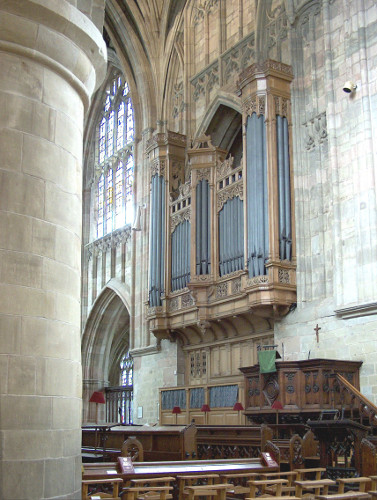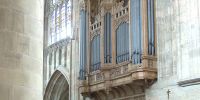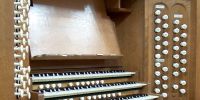
Malvern Priory and Nicholson & Co. have a connection that goes back over 160 years. John Nicholson built a substantial two-manual organ in 1850 which he enlarged to three manuals in 1862, then four manuals with lever-pneumatic action in 1880. The priory organist at the time, William Haynes, was a keen patron of the firm and went on to become its proprietor when John retired in 1886.
This organ served until 1927 when Rushworth & Dreaper re-used most of the John Nicholson pipework in an otherwise new organ. While well made and long-lived, its tubular pneumatic action was complex and inaccessible. Much of the action was passed over in a major overhaul in 1977 and by the 1990s, deep-seated faults were causing serious trouble. Wind was distributed throughout the organ at high pressure and major leaks had developed that could not be repaired without completely dismantling the action and the console.
The Nicholson & Co. rebuild in 2003/2004 retained the 1927 organ’s character by respecting its tonality and the appearance of the console and the distinguished Caröe case, while providing a reliable and easily maintained organ to enhance the Priory’s fine musical tradition and produce more tone in the nave. A fast high-pressure electro-pneumatic action replaced the tubular pneumatics. Separate high and medium pressure blowers in the chamber replaced the noisy single-stage blower in the churchyard and wind trunks were strengthened and re-routed to avoid the repetition of past problems.
Space saved within the organ made it possible to move the Swell box out of its side chamber (where its back faced the nave congregation and it spoke east into the side of the Solo box), to a conventional position behind the Great. The unenclosed Choir was moved forward and the side arch opened up to improve the egress of the Pedal organ. Every part of the organ can now be reached should the need arise.
The Swell is still subservient to the Great but the soft stops can now be heard effectively. Choristers and congregation hear the Great in a better balance. Delicate stops of the Choir can now be heard in a new light. Independent soundboard actions have made possible a ‘Great Reeds on Choir’ drawstop to enable the family of Great Trombas to be used in solo. This is a powerful organ, well suited to the leading of the Priory’s large congregations, but it also has a wealth of quiet 8ft tone making it ideal for the accompaniment of Anglican liturgy.



